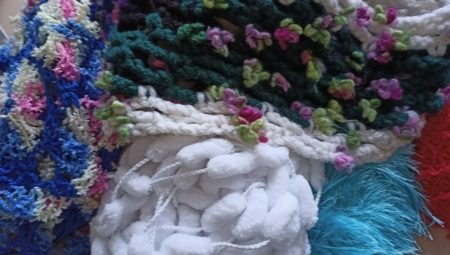Features and types of fancy yarns

It would seem, what could be unusual about yarn. The traditional thread used in knitting everyday clothes is really nothing out of the ordinary. Yes, it will differ in material, thickness, texture, quality, but these will be the usual threads. Fantasy yarn is another matter. In these amazing skeins and threads, you do not always recognize. Let's talk about this yarn in more detail.



general description
By and large, working with fancy yarn is not much different from the one that the craftswomen are used to. It is suitable for hand knitting, crochet or fork, the main thing is to choose the right size of the tool. But the differences are noticeable in the appearance of the products.
They can be very diverse. For example, melange yarn, in which ordinary and decorative yarns are mixed. An example of this is yarn with lurex. Another option is threads with special weaving, fibers of different lengths or colors, for example, ribbon yarn.
Such threads give the fancy of the needlewoman to the fullest to unfold. Playing with the color and texture of the threads, you can get a unique product. Moreover, the list of species is constantly updated with something new.



Species overview
It is worth telling separately about some of the types of unusual threads on the market.
- Section dyed yarn... A thread, ordinary in texture, but dyed in several colors at once.
The simplest of the types of fancy yarn externally, but rather difficult to work with, especially if the goal is to knit a product with a certain pattern.


- Bulky, she is "thick". Almost everyone has seen products made from such yarn. Bulky scarves, blankets, furniture covers, even coats. The yarn looks soft and cozy, that's why it looks so good in the interior.Large, thick threads (often in pastel colors) are the hallmarks of this material that came from America.
If you want to add even more uniqueness to things made from such yarn, you can try to knit it by hand, without needles or crochet.


- Jersey... Another option that has become popular in recent years. Easy to work, suitable for beginners, but at the same time allows you to create both voluminous products, if you work with a thick tool, and dense fabric, using thin knitting needles or a crochet hook.


- Tape... Flat threads that allow you to create a very unusual canvas. The structure can be single-layer or double-layer. They are made of acrylic, cotton, viscose, synthetics, pure or with cotton, less often woolen ribbons can be found.
The same variety is observed in the color range - monochromatic yarn, models with a smooth color transition, melange.

- With lurex. Synthetic yarn with interweaving of shiny threads. Looks great as a complement to base yarns or as a base material for evening wear. Unfortunately, due to its structure, it can often be prickly.

- With beads or sequins... Another version of the "evening" yarn. It is interesting in that, with a strong desire, it can be made independently, without much difficulty.


- Pomponnaya... A thread with pom-pom thickenings, located at the same distance from each other. Almost entirely made of pom-poms, the canvas will look good in children's clothes, decorative elements.
Despite the unusual shape, it is quite easy to work with yarn, with which you can create very cute things.


- Tweed... Solid threads with colored inclusions are recognizable and perfect for creating clothes in a classic English style.
Unfortunately, real tweed yarn is not cheap, and quality may suffer from budget counterparts.


- Chenille... Soft, "plush", usually made of pure acrylic, or acrylic mixed with cotton. Suitable for toys, adult and children's clothing.
But with this yarn, like no other, you need to be careful when choosing - low-quality samples can quickly begin to peel off and look bald.


- Bouclated... Imitating fur, somewhat similar to astrakhan fur, bouclé yarn is often used in outerwear. Despite the texture, it is very pleasant to the touch.
For beginners, this option is good because, due to the structure of the threads, the pattern, and therefore the shortcomings, will not be conspicuous.


- Pile... Another type, "disguised" as fur. A well-known subspecies of this yarn is synthetic grass.
When working with the latter, it is important to take into account that it visually makes the product heavier, and it does not hold its shape in the best way. Things made from it are suitable only for hand washing, and you cannot iron them at all.


- With threads of different thicknesses... An interesting pattern that will look good in simple cut models.

- Ryusha... Rather finishing than the main option. It is used to decorate the edges of clothing.

- Cord... It usually looks like an ordinary hollow lace, synthetic or woolen. The first is good for knitting rugs, the second is good for bags, belts and even clothes.


What can be linked?
Fantasy yarns in all their variety have a corresponding wide application. It is used both as an addition to traditional yarn and as a base material. From the general recommendations, it is important to remember the following: the more original and brighter the appearance of the threads themselves, the easier the cut of the product should be, then everything will look harmonious.
Here are some examples of using unusual threads.
- Tape: clothing and accessories, primarily handbags. All kinds of containers and baskets for the home.
- Jersey: clothes, including summer clothes, rugs.
- Pomponnaya: blankets, blankets, scarves, hats.
- "Grass": toys, clothing, decoration.
- Thick: interior elements, including poufs, blankets.
- Bouclé and pile: ponchos, outerwear, cushions, toys.
- Chenille: soft toys, blankets, clothes.


When working with unusual yarns, the main thing is not to be afraid to experiment. Then the yarn "Fantasy" will help to bring all your most daring projects to life.








